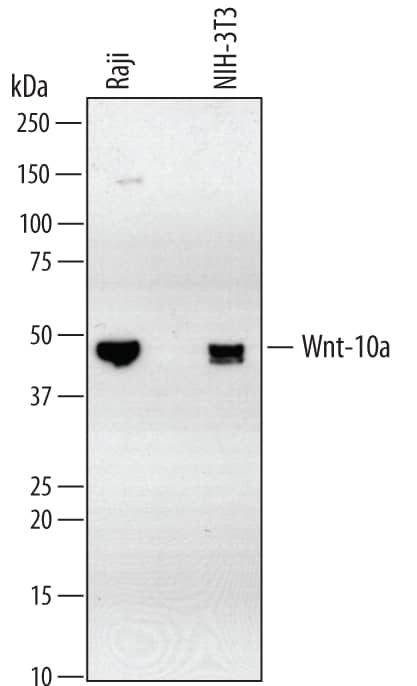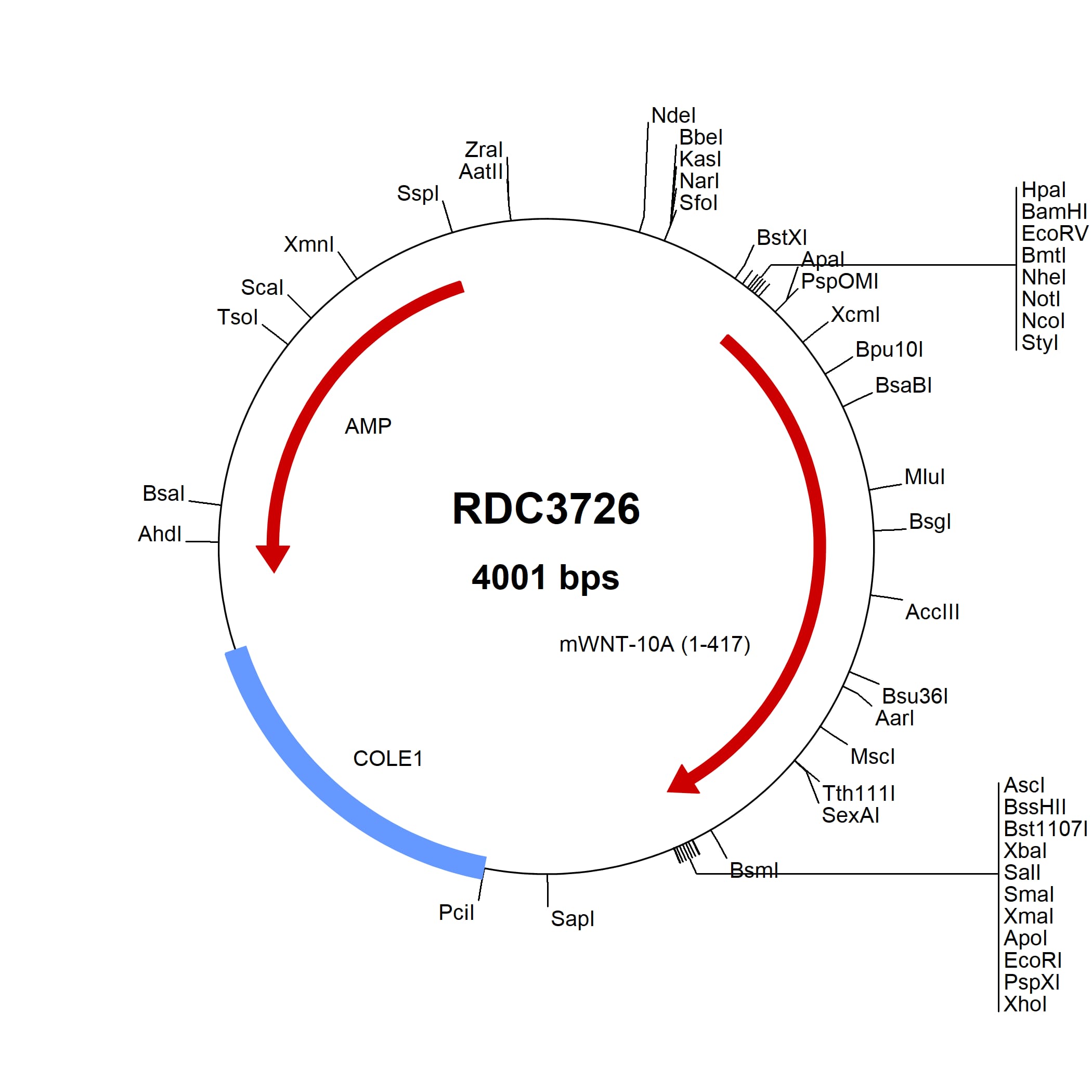Wnt-10a Products
Wnt-10a is a presumably secreted, glycosylated member of the Wnt family of developmental proteins. Mouse Wnt-10a is synthesized as a 417 amino acid (aa) precursor that contains a 382 aa mature region. The mature region contains 24 cysteines and two potential N-linked glycosylation sites. Mature mouse Wnt-10a is 96% and 99% aa identical to mature human and rat Wnt-10a, respectively. Wnt-10a is 64% aa identical to Wnt-10b/12. Wnt-10a is produced by tumors and thymic epithelium.
The Wnts make up a large family of secreted proteins with roles in pattern formation, cell fate decision, axon guidance, and tumor formation. Wnt family members vary in length between 350 and 400 aa, possess 22 to 24 conserved cysteines, are highly hydrophobic, and show 20 - 85% aa identity within the Wnt family. In general, there are three signaling pathways associated with Wnt-receptor interaction. The first is commonly called the canonical pathway and ultimately culminates in beta-Catenin accumulation and TCF/LEF-1-mediated gene transcription. The other two less well-defined non-canonical pathways include the Wnt/Ca2+ pathway and the planar cell polarity (PCP) pathway.
42 results for "Wnt-10a" in Products
42 results for "Wnt-10a" in Products
Wnt-10a Products
Wnt-10a is a presumably secreted, glycosylated member of the Wnt family of developmental proteins. Mouse Wnt-10a is synthesized as a 417 amino acid (aa) precursor that contains a 382 aa mature region. The mature region contains 24 cysteines and two potential N-linked glycosylation sites. Mature mouse Wnt-10a is 96% and 99% aa identical to mature human and rat Wnt-10a, respectively. Wnt-10a is 64% aa identical to Wnt-10b/12. Wnt-10a is produced by tumors and thymic epithelium.
The Wnts make up a large family of secreted proteins with roles in pattern formation, cell fate decision, axon guidance, and tumor formation. Wnt family members vary in length between 350 and 400 aa, possess 22 to 24 conserved cysteines, are highly hydrophobic, and show 20 - 85% aa identity within the Wnt family. In general, there are three signaling pathways associated with Wnt-receptor interaction. The first is commonly called the canonical pathway and ultimately culminates in beta-Catenin accumulation and TCF/LEF-1-mediated gene transcription. The other two less well-defined non-canonical pathways include the Wnt/Ca2+ pathway and the planar cell polarity (PCP) pathway.
| Applications: | AC |
| Reactivity: | Human, Mouse |
| Details: | Rat IgG1 Monoclonal Clone #342811 |
| Applications: | WB |
| Reactivity: | Human, Mouse, Rat |
| Details: | Rabbit IgG Polyclonal |
| Applications: | IHC, WB, ELISA, ICC/IF |
| Reactivity: | Human, Canine, Monkey, Bovine, Primate, +2 More |
| Details: | Rabbit IgG Polyclonal |
| Applications: | IHC |
| Reactivity: | Human, Rabbit |
| Details: | Rabbit IgG Polyclonal |
| Applications: | IHC, WB |
| Reactivity: | Human |
| Details: | Rabbit Polyclonal |
| Applications: | IHC |
| Reactivity: | Human |
| Details: | Rabbit IgG Polyclonal |
| Applications: | WB, ICC/IF |
| Applications: | AC |
| Reactivity: | Human |
| Details: | Rabbit IgG Polyclonal |
| Applications: | IHC |
| Applications: | ELISA |
| Applications: | ELISA |
| Reactivity: | Human, Mouse, Rat |
| Details: | Rabbit IgG Polyclonal |
| Applications: | IHC, WB, ELISA, ICC/IF |
| Reactivity: | Human, Mouse, Rat |
| Details: | Rabbit IgG Polyclonal |
| Applications: | IHC, WB, ELISA, ICC/IF |
| Reactivity: | Human, Mouse, Rat |
| Details: | Rabbit IgG Polyclonal |
| Applications: | IHC, WB, ELISA, ICC/IF |
| Reactivity: | Human, Mouse, Rat |
| Details: | Rabbit IgG Polyclonal |
| Applications: | IHC, WB, ELISA, ICC/IF |
| Reactivity: | Human, Mouse, Rat |
| Details: | Rabbit IgG Polyclonal |
| Applications: | IHC, WB, ELISA, ICC/IF |
| Reactivity: | Human, Mouse, Rat |
| Details: | Rabbit IgG Polyclonal |
| Applications: | IHC, WB, ELISA, ICC/IF |
| Reactivity: | Human, Mouse, Rat |
| Details: | Rabbit IgG Polyclonal |
| Applications: | IHC, WB, ELISA, ICC/IF |
| Reactivity: | Human, Mouse, Rat |
| Details: | Rabbit IgG Polyclonal |
| Applications: | IHC, WB, ELISA, ICC/IF |
| Reactivity: | Human, Mouse, Rat |
| Details: | Rabbit IgG Polyclonal |
| Applications: | IHC, WB, ELISA, ICC/IF |
| Reactivity: | Human, Mouse, Rat |
| Details: | Rabbit IgG Polyclonal |
| Applications: | IHC, WB, ELISA, ICC/IF |
| Reactivity: | Human, Mouse, Rat |
| Details: | Rabbit IgG Polyclonal |
| Applications: | IHC, WB, ELISA, ICC/IF |
| Reactivity: | Human, Mouse, Rat |
| Details: | Rabbit IgG Polyclonal |
| Applications: | IHC, WB, ELISA, ICC/IF |



![Western Blot: Wnt-10a AntibodyBSA Free [NBP1-76916] Western Blot: Wnt-10a AntibodyBSA Free [NBP1-76916]](https://resources.bio-techne.com/images/products/Wnt-10a-Antibody-Western-Blot-NBP1-76916-img0002.jpg)


![Immunohistochemistry-Paraffin: Wnt-10a Antibody - BSA Free [NB100-59026] Immunohistochemistry-Paraffin: Wnt-10a Antibody - BSA Free [NB100-59026]](https://resources.bio-techne.com/images/products/Wnt-10a-Antibody---BSA-Free-Immunohistochemistry-Paraffin-NB100-59026-img0005.jpg)
![Western Blot: Wnt-10a Antibody [NBP1-69116] Western Blot: Wnt-10a Antibody [NBP1-69116]](https://resources.bio-techne.com/images/products/Wnt-10a-Antibody-Western-Blot-NBP1-69116-img0001.jpg)
![Immunohistochemistry-Paraffin: Wnt-10a Antibody [NBP3-14379] Immunohistochemistry-Paraffin: Wnt-10a Antibody [NBP3-14379]](https://resources.bio-techne.com/images/products/Wnt-10a-Antibody-Immunohistochemistry-Paraffin-NBP3-14379-img0003.jpg)
![Immunocytochemistry/ Immunofluorescence: Wnt-10a Antibody [NBP1-33039] Immunocytochemistry/ Immunofluorescence: Wnt-10a Antibody [NBP1-33039]](https://resources.bio-techne.com/images/products/Wnt-10a-Antibody-Immunocytochemistry-Immunofluorescence-NBP1-33039-img0004.jpg)
![Immunohistochemistry-Paraffin: Wnt-10a Antibody [NBP1-86081] Immunohistochemistry-Paraffin: Wnt-10a Antibody [NBP1-86081]](https://resources.bio-techne.com/images/products/Wnt-10a-Antibody-Immunohistochemistry-Paraffin-NBP1-86081-img0006.jpg)
![ELISA: Human Wnt-10a ELISA Kit (Colorimetric) [NBP3-38884] Human Wnt-10a ELISA Kit (Colorimetric)](https://resources.bio-techne.com/images/products/nbp3-38884_human-wnt-10a-elisa-kit-colorimetric-211020241538067.png)
![ELISA: Human Wnt-10a - Ready-To-Use ELISA Kit (Colorimetric) [NBP3-38883] Human Wnt-10a - Ready-To-Use ELISA Kit (Colorimetric)](https://resources.bio-techne.com/images/products/nbp3-38883_human-wnt-10a-ready-to-use-elisa-kit-colorimetric-211020241530295.png)
